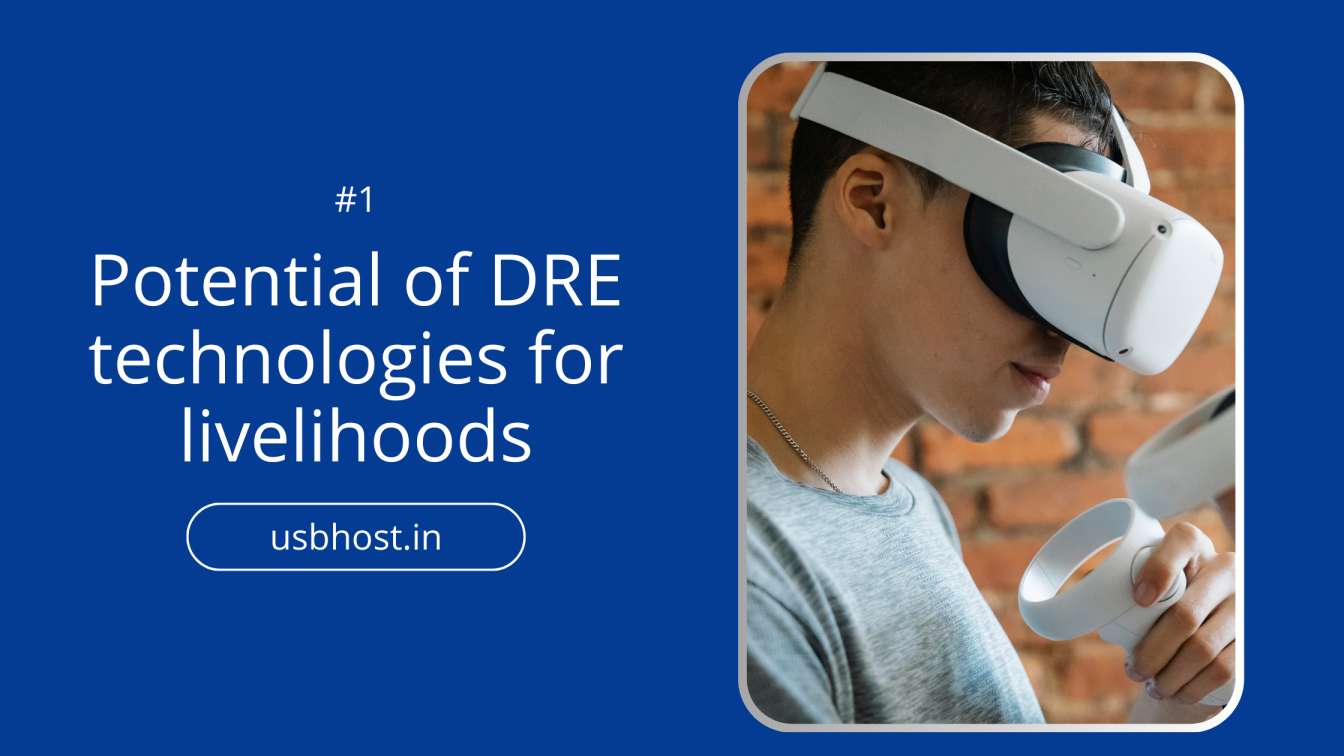“DRE Technologies for Livelihoods” – Explore the transformative potential of distributed renewable energy (DRE) technologies in enhancing livelihoods and sustainable development. Find out how these innovative solutions empower communities, promote economic growth and resilient livelihoods, and Create opportunities.

Table of Contents
Empowering rural entrepreneurs: Grassroots nonprofit organizations use decentralized renewable energy to promote small business growth in rural areas of India.
Over the past ten years, access to electricity in rural Indian households has significantly increased. Nevertheless, the reliability of this vital service remains questionable, often characterized by irregular supply. This inconsistency seriously hampers economic efforts, especially for the more than 4 million rural micro-enterprises engaged in food processing, post-harvest management, and apparel production. The World Bank Enterprise Survey underlines the gravity of the situation, revealing that more than 55 percent of manufacturing and service sector enterprises in India face power disruptions an average of 14 times every month. Such disruptions significantly hinder the continued growth of these businesses, underscoring the urgent need for improved and stable energy infrastructure in rural areas.
India’s net-zero ambitions include deriving 50 percent of its electricity from non-fossil fuels by 2030. This shift could revolutionize energy access for micro-enterprises, providing opportunities for sustainable growth and lower environmental impact in line with India’s climate goals.
At the heart of this strategy are distributed renewable energy (DRE) projects, which involve generating electricity from renewable sources such as solar, wind, biomass, or small hydro, close to the point of consumption. Unlike centralized power plants, DRE systems are localized and modular, meeting the energy needs of specific communities, businesses, or homes, especially in remote or underserved areas of the country. This decentralized approach increases energy access and promotes resilience and sustainability, aligning with India’s broader goals of promoting renewable energy and ensuring equitable energy access across diverse scenarios.
This paradigm shift in energy use for livelihoods includes powering essential equipment such as irrigation pumps, refrigerators, and food processors through reliable DRE sources, thereby reducing the impact of irregular power supply. Furthermore, integrating energy-efficient motors into these devices reduces energy consumption. For small businesses and micro enterprises, adopting biomass-powered cold storage, solar dryers, food processing machines, solar pumps, and refrigerators provides sustainable energy solutions, boosting resilience and productivity across various sectors.
Consider Lalita Devi, a member of Khet Kisan Producer Company, an eight-year-old farmer-producer organization (FPO) in Saraipur village in Uttar Pradesh. Lalita and her fellow farmers are experts in banana farming. Previously, they struggled with an unreliable power supply, which caused their produce stored in two deep freezers and a refrigeration unit to spoil. This caused huge financial losses to the farmers. To overcome this challenge, they adopted refrigeration technology powered by biomass or agricultural waste. With improved storage conditions, the shelf life of their produce increased, reducing the pressure to sell immediately and reducing income loss and wastage on the farm. As a result, the annual turnover of the FPO increased to Rs 1 crore, which is a significant achievement in reducing losses and increasing profitability through sustainable and resilient farming practices.
Livelihood Opportunity of DRE
Recognizing the transformative potential of distributed renewable energy (DRE) in promoting rural micro-enterprises and inclusive economic growth, the Government has launched several initiatives to promote DRE technology. One such milestone is releasing a comprehensive DRE policy framework by the Ministry of New and Renewable Energy (MNRE) in February 2021. This framework advocates the integration of DRE technologies into livelihood programs across various ministries, including rural development, agriculture and welfare, and tribal affairs, thereby facilitating synergistic efforts for the upliftment of marginalized communities. Furthermore, there is significant potential for collaboration between national and local initiatives focused on livelihood enhancement, Such as PM Formalization of Food Processing Micro Enterprises (PMFME), National Agricultural Infra Financing Facility, and Mudra Scheme, which have increased the impact of DRE interventions in driving sustainable and inclusive economic growth at the grassroots level.
Consider Ramesh Khangoudar, a farmer from Belagavi, Karnataka, whose farming activities were severely disrupted due to frequent power cuts in his village. Determined to find a more reliable solution for processing his crops after harvest, Ramesh ventured into solar-powered technology. With the help of financial assistance given under the PMFME initiative for food processing entrepreneurs, he purchased a solar-powered oil extraction unit, flour mill, and turmeric pounder. Taking advantage of these advances, Ramesh set up a small agro-processing business and marketed his agro-processed goods under his brand name through a local small shop. This transformation not only reduced the challenges posed by irregular power supply but also empowered Ramesh to expand his farming operations and contribute to the local economy through value-added products.
Global philanthropic organizations such as Good Energies, the IKEA Foundation, and DOEN are supporting universal energy access. The IKEA Foundation, in collaboration with GIZ, supports small farmers and food producers in accessing distributed renewable energy (DRE). Despite these efforts, significant barriers remain, hindering the widespread adoption of DRE technology.
High costs of technology: Despite the long-term cost-effectiveness of distributed renewable energy (DRE) solutions compared to grid or diesel alternatives, their initial capital investment remains a significant barrier for microentrepreneurs. For example, a basic solar-powered refrigerator may cost around Rs 80,000, which is a huge sum for small shop owners or marginal fishermen whose monthly income is on average Rs 9,000. In such scenarios, access to financing becomes critical for DRE adoption, yet many financial institutions lack these technologies in their portfolios, making loan acquisition challenging. Bridging this financing gap is essential to achieve widespread adoption of DREs among marginalized communities, ensure equitable access to sustainable energy solutions, and promote economic empowerment at the grassroots level.
Hesitation among buyers: The tactile experience of technology is important to instill confidence in buyers. For example, a dairy farmer in Rajasthan may need first-hand experience to consider adopting a solar refrigerator. Thus, local availability of such technologies is critical, leading manufacturers to prioritize accessibility for potential users.
Limited training: Distributed renewable energy (DRE) livelihood technologies are still in their infancy and have not been fully integrated into livelihood practices. As a result, there is a lack of skills training modules required to operate and maintain these technologies. However, manufacturers face resource limitations hindering their ability to provide comprehensive training support. This lack of skills training and capacity building delays or prevents the adoption of DRE technologies. It is important to bridge this gap to maximize the potential benefits of DRE solutions in enhancing livelihoods and promoting sustainable development in diverse communities.
Lack of after-sales service support and market contact: Establishing market linkages and providing strong after-sales services are important to ensure the long-term use of such technologies. Both backward (raw material sourcing) and forward (product marketing) market linkages are important to sustain the use of these technologies. For example, for silk reeling machines to operate effectively, a continuous supply of cocoons and a market for the sale of silk thread are indispensable. In addition, local after-sales services including repairs and customer service support are essential for timely maintenance and resolution of any usage-related queries. By facilitating market access and offering comprehensive after-sales support, stakeholders can enhance the longevity and efficacy of these technologies, thereby promoting sustainable livelihoods and economic development in diverse communities.
Grassroots nonprofits can play an important role in driving the adoption of DRE technology
There is a need for collaborative efforts at various levels to mainstream distributed renewable energy (DRE) for livelihoods. Convergence is evident at the national and sub-national levels, yet ecosystem-wide collaboration is needed to ensure widespread adoption by microentrepreneurs. It is important to integrate existing livelihood initiatives with DRE technology at the grassroots level, underscoring the critical role of grassroots nonprofits in driving this transformation.
Leveraging existing networks for awareness building:
Grassroots organizations have established networks in specific areas, providing an infrastructure that can be used for awareness campaigns. Regional centers can serve as demonstration centers, educating smallholder farmers on DRE technologies and demonstrating their positive impacts. By collaborating with social startups, on-ground campaigns can focus on spreading knowledge and promoting community awareness. Furthermore, these organizations act as important intermediaries, facilitating feedback loops between manufacturers and end users, and ensuring technology alignment with user needs.
Facilitating Financing Pathways:
These organizations play an important role in sensitizing partner financiers such as microfinance institutions (MFIs) and rural banks about the potential of DRE technologies. By sharing success stories and impact evidence, they increase financiers’ confidence in integrating DRE livelihood technologies into their portfolios. Additionally, using their network of farmer-producer organizations (FPOs) and self-help groups, organizations can facilitate group-based lending for large-scale technologies such as biomass cold storage or solar dryers. This collaborative approach increases the feasibility of lending for financiers, as the joint liability mechanism mitigates risks and ensures repayment reliability, ultimately promoting broader access to DRE technologies among marginalized communities.
Harnessing Existing Market Linkages:
It is important to utilize pre-established market connections within the sector to ensure successful sales of products resulting from DRE-based production. For example, non-profit organizations associated with women microentrepreneurs have usually established market channels for their products. These channels can be expanded to accommodate goods produced through DRE technologies. Collaborating with startups like KrishiHub and Hesa, which are renowned for their wide market networks, especially for value-added products like jams, dried mangoes, and pickles, can increase market penetration and facilitate product distribution.
Enabling Skill Training Initiatives
Livelihood organizations play an important role in training the local workforce to install, repair and maintain DRE technologies, thereby promoting employment generation opportunities. Grassroots-level organizations can host training programs aimed at educating individuals on the functionality and application of these technologies to enhance livelihoods. By equipping technicians with the necessary skills, these initiatives ensure last-mile coverage, facilitating seamless adoption and continued operation of DRE technologies within marginalized communities.
For maximum adoption of DRE technologies, it is necessary to integrate them into ongoing livelihood initiatives. Collaborating with grassroots nonprofits that are deeply engaged in addressing livelihood challenges provides a strategic approach. These organizations have valuable resources, community synergy, and last-mile access that is critical to advancing DRE technologies. However, additional support from stakeholders and philanthropists is essential. This collective effort promotes sustainable livelihood opportunities, brings green alternatives closer to communities, and accelerates India’s transition to net zero emissions.

